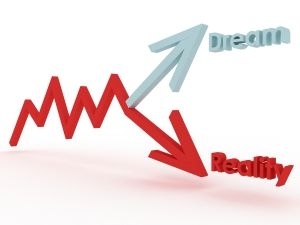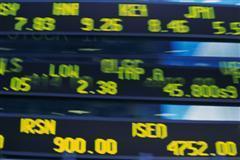| Home | About | Archives | RSS Feed |

@theMarket: Jobless Number Spoils the Party
 Up until Friday's disappointing unemployment numbers, the stock market appeared ready to regain the year's high all in one week. However, the ugly news that the nation hired a meager 18,000 of our unemployed dashed investor's hopes that the economy might be gaining strength in the second half.
Up until Friday's disappointing unemployment numbers, the stock market appeared ready to regain the year's high all in one week. However, the ugly news that the nation hired a meager 18,000 of our unemployed dashed investor's hopes that the economy might be gaining strength in the second half.
Equities plummeted across the board, as did commodities, while Treasury bonds and gold provided safe havens for worried investors. The Republicans were quick to call a news conference highlighting the Obama administration's failure to create jobs while providing platitudes on how to get America back to work. Unfortunately, neither party has come up with anything close to effective in combating unemployment here at home.
Unfortunately, much of what ails our country's work force has little to do with the here and now. For years, unskilled jobs in environmentally unfriendly industrial and manufacturing industries have been exported overseas. At the same time the construction sector, which had absorbed so much of the unskilled labor pool, is in the doldrums.
Both the government and private sectors have exhorted America's future workers to stay in school, go to college or technical school and obtain skills that would be salable in the new service/technical economy of the country. Instead, the dropout rate has increased while our educational system has continued to decline. Older workers, for the most part, have also refused to either go back to school or acquire new skills.
Now, before we get all jumpy about one month's unemployment numbers remember that the standard deviation (the accuracy) of any one job number is plus/minus 100,000 jobs. That’s right, this week’s number may be off by as much as 86,000 and we won’t know the true figure for months!
But the string of disappointing employment numbers recently has quite a bit to do with layoffs in the public sector. Recall that there was a big spike in the unemployment rate a few months back when U.S. census workers were terminated. Now we are experiencing a new wave of municipal layoffs. Federal aid to states has declined drastically. At the same time, almost every state finds itself in debt with the need to balance their budgets. So unemployment is being fueled by layoffs among state workers with the biggest hit in the health and education areas.
What concerns me most about that is the demand by the Republicans (Tea Party) to cut spending drastically right now. Has anyone given thought to how that is going to impact unemployment and growth in the next six months? For some reason I can't fathom, the GOP believes as long as taxes remain the same everything will be fine. That math doesn't add up.
What I hope comes out of Sunday's negotiations between the leaders of the two parties is a plan to cut the deficit over the long term while continuing to stimulate the economy in the short term. You might argue that I can't have both. But what if we all agreed to cuts in entitlements such as Medicare/Medicaid and higher taxes but wait a year or two, say 2013, before putting that plan into action? At the same time, continue tax breaks this year for both corporations and individuals.
That would give the economy the breathing room to gather strength while giving all of us a heads-up on what's coming around the corner. A deal like that would give the markets confidence that Washington is doing something about the deficit while removing another stress factor (the debt ceiling) from the markets. As for the markets, I remain bullish. After a 6 percent move up in one week, a 1 or 2 percent decline would be a normal reaction.
Bill Schmick is an independent investor with Berkshire Money Management. (See "About" for more information.) None of the information presented in any of these articles is intended to be and should not be construed as an endorsement of BMM or a solicitation to become a client of BMM. The reader should not assume that any strategies, or specific investments discussed are employed, bought, sold or held by BMM. Direct your inquiries to Bill at (toll free) or e-mail him at wschmick@fairpoint.net . Visit www.afewdollarsmore.com for more of Bill's insights.
| Tags: jobs, debt ceiling, education |
@theMarket: Jobs Versus the Market
 The May non-farm payroll jobs report was a disappointment. So much so that investors dumped stocks, convinced that because the country only added 54,000 jobs, the economy is kaput and we all headed for economic Armageddon. Now, doesn't that sound silly?
The May non-farm payroll jobs report was a disappointment. So much so that investors dumped stocks, convinced that because the country only added 54,000 jobs, the economy is kaput and we all headed for economic Armageddon. Now, doesn't that sound silly?
Let's get real folks. We didn't lose 300,000 jobs last month, which might have justified Friday morning's sell-off. Sure, economists were looking for a job gain of 100,000 plus but why should any one be surprised that unemployment is still above 9 percent given the slow growth rate of our economy?
Since the end of the recession, quarterly GDP has been at best erratic. Beginning with the third quarter of 2009, we have experienced the following string of quarterly numbers: 1.6, 5.0, 3.7, 1.7, 2.6, 3.1, 1.8 percent. All but one of those quarters have trended well below the normal economic recovery rates associated with the end of a recession. Is it any wonder that our unemployment rate bounces around while remaining inordinately high?
The spate of negative economic numbers we have been experiencing of late, in my opinion, has much more to do with the body blow Japan has taken from its earthquake and aftermath. After all, Japan is the second largest economy in the world and the fallout from its present recession impacts everyone.
As for the markets, I believe there are similarities between the April-August period of last year and what is happening today. At that time investors were concerned that we were falling back into a double dip recession. GDP for the second quarter of 2010 had dropped to 1.7 percent from 3.7 percent, while unemployment hovered at 10 percent.
The S&P 500 Index fell by over 16 percent. It was only after the Federal Reserve Bank announced the possibility of QE II that the markets recovered in August. Now the S&P is almost 300 points higher.
Last quarter's GDP growth rate was 1.8 percent down from 3.1 percent the quarter before and unemployment is 9.1 percent, up a smidgeon from last month. Unlike last year, however, we face the "end" of QE II in less than 30 days.
Readers may recall that I discounted a double-dip recession last year. I argued that we were in a slow growth recovery and should expect erratic and conflicting economic data into the foreseeable future. As long as the housing market remains in the doldrums, so will the economy. That argument still holds. At the same time, if the economy slows further, the Fed still has our back no matter how many QEs it takes.
What investors tend to forget is that we narrowly escaped a second worldwide Depression two years ago. While politicians, investors and taxpayers alike speechify about our government's huge deficit and wasteful spending, they should stop and ask why the deficit and spending is where it is today.
As a result of the financial crisis, the deleveraging of debt in the private sector was an absolute necessity. The only way to accomplish that, without driving the world over the brink, was for the government to take on that debt (deliberately leveraging the public sector balance sheet) while, at the same time, spending as much as possible to jump start the economy.
To date, that strategy has worked, although not as perfectly as certain textbook economists might have hoped. We have averted a Depression although this last Great Recession is not like any of the recessions we have experienced since the end of WW II. It is going to take time, effort and patience to unwind the financial tangle that our banks, brokers and insurance companies have created. We are on the right track, even if our path ahead is dimly lit. Expect the track to run through peaks and valleys, make sharp turns, and accelerate at times, while coasting at others. In the meantime, stay the course.
As I write this, the markets are wrestling with 1,300 on the S&P 500 Index, the bottom end of my projected range. Could the markets fall even further? Of course, they can. If we break 1,300, the next stop would be 1,250-1,275, still not the end of the world. From top to bottom that would be an 8 percent correction, after a 300-point rally over 11 months. I'll gladly accept that kind of pullback for a chance to rally up to 1,400 or above.
Bill Schmick is an independent investor with Berkshire Money Management. (See "About" for more information.) None of the information presented in any of these articles is intended to be and should not be construed as an endorsement of BMM or a solicitation to become a client of BMM. The reader should not assume that any strategies, or specific investments discussed are employed, bought, sold or held by BMM. Direct your inquiries to Bill at (toll free) or e-mail him at wschmick@fairpoint.net. Visit www.afewdollarsmore.com for more of Bill's insights.
| Tags: jobs, unemployment, economy |
@theMarket: Is September's Rally Stalling or Pausing?
 After opening the month with a 5 percent market melt-up, investors were expecting a follow-through this week that would take the averages higher. There was even talk of a possible break through the ceiling of this almost six-month trading range. Instead we only managed a couple point gain over last week's close on the S&P 500.
After opening the month with a 5 percent market melt-up, investors were expecting a follow-through this week that would take the averages higher. There was even talk of a possible break through the ceiling of this almost six-month trading range. Instead we only managed a couple point gain over last week's close on the S&P 500.
That was despite some "good" economic news on the unemployment front. Initial unemployment claims were down by 27,000 and continuing claims fell 2,000, the best in two months... The bears argue that not all states submitted employment numbers so optimistic estimates were used instead, in some cases. They also point out that once a person's unemployment runs out they are no longer officially counted as unemployed. The advance guard of this group (those who were left go early in the recession and still have not found a job) exhausted their extended benefits beginning in June. Unfortunately, as time goes bye, more and more unemployed Americans will fall into this category well into the middle of next year.
Over in euro land things were a bit dicier with increased concerns over European debt levels, problems with Anglo Irish Bank and the "news" that Europe's bank stress test understated lender's holdings of risky government debt. Readers may recall that I had grave reservations over this very same issue when the results were first announced weeks ago.
Most of the market's attention has turned to the Obama administration's non-stimulus, stimulus plan. That some Wall Street players got an advanced look at the administration's thinking was, in my opinion, the source of last week's rally. Now that we have the details, the markets seem to be decidedly unimpressed.
As readers recall, I explained that a good portion of the money from the first stimulus plan was deliberately held back until this summer in order to help the incumbent party get re-elected. That may have been a miscalculation on the part of the Democrats, who could have been overly confident of the economic impact of Stimulus One. To date, 77 percent of the $288 billion that was earmarked for tax benefits have been spent, only 53 percent of the $275 billion available for contracts, grants and loans has been distributed and only 64 percent of entitlements, or $144 billion out of $224 billion was doled out to the country. Obviously those levels of s
